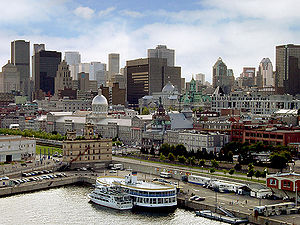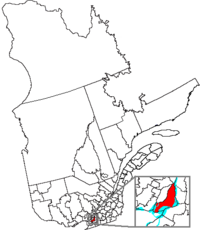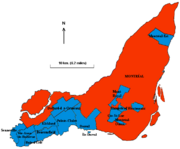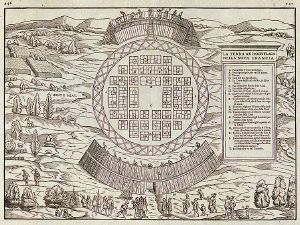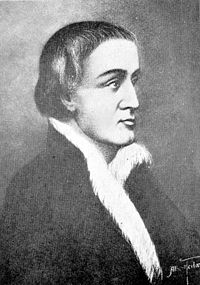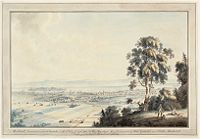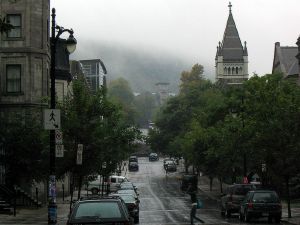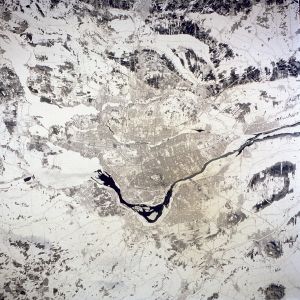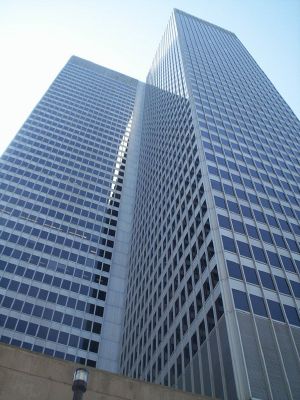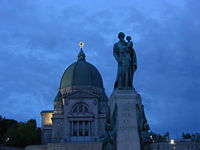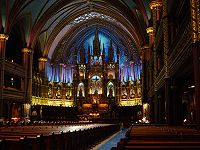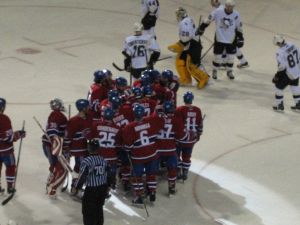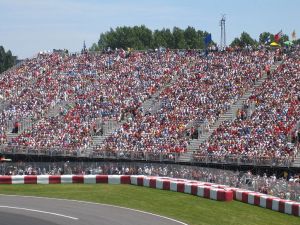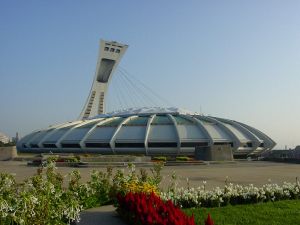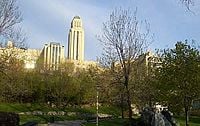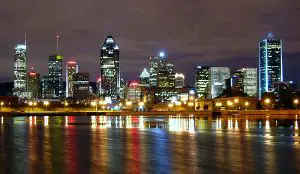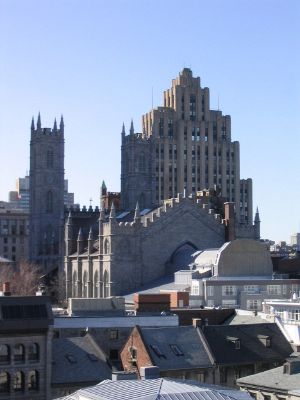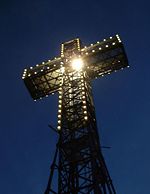Montreal, Quebec
(images ok) |
Rosie Tanabe (talk | contribs) |
||
| (40 intermediate revisions by 8 users not shown) | |||
| Line 1: | Line 1: | ||
| − | {{Images OK}}{{Submitted}}{{ | + | {{Approved}}{{Images OK}}{{Submitted}}{{Paid}}{{Copyedited}} |
| − | + | {{epname|Montreal, Quebec}} | |
| − | {{Infobox | + | {{Infobox Settlement |
| − | |official_name | + | |official_name = Ville de Montréal |
| − | + | |name = Montreal | |
| − | | | + | |settlement_type = City |
| − | | | + | |image_skyline = Mont.jpg |
| − | |image_skyline | + | |image_caption = |
| − | |image_flag | + | |image_flag = Flag of Montreal.svg |
| − | |image_shield | + | |imagesize = 300px |
| + | |image_shield = montrealcoa.gif | ||
| + | |image_blank_emblem = | ||
| + | |motto = [[Concordia Salus]] ("well-being through harmony") | ||
|image_map = Quemtl3.PNG|200px|Location of Montreal] | |image_map = Quemtl3.PNG|200px|Location of Montreal] | ||
|mapsize = 200px | |mapsize = 200px | ||
| − | |map_caption = | + | |map_caption = |
| − | | | + | |image_map1 = Montreal2006.png |
| − | | | + | |map_caption1 = City of Montreal and enclave municipalities |
| − | | | + | |mapsize1 = 180px |
| − | | | + | |pushpin_map = |
| − | | | + | |coordinates_region = CA-QC |
| − | | | + | |subdivision_type = Country |
| − | | | + | |subdivision_type1 = [[Provinces of Canada|Province]] |
| − | | | + | |subdivision_type2 = Regional County |
| − | | | + | |subdivision_name = {{CAN}} |
| − | | | + | |subdivision_name1 = {{flag|Quebec}} |
| − | | | + | |subdivision_name2 = [[Urban agglomeration of Montreal|Montreal (06)]] |
| − | | | + | |leader_title = [[Mayor of Montreal|Mayor]] |
| − | | | + | |leader_name = [[Gérald Tremblay]] |
| − | | | + | |established_title = Founded |
| − | |area_magnitude | + | |established_date = 1642 |
| − | |area_footnotes | + | |established_title2 = Established |
| − | |area_magnitude | + | |established_date2 = 1832 |
| − | | | + | |parts_type =Boroughs |
| − | | | + | |parts_style = <!-- =list (for list), coll (for collapsed list), para (for paragraph format) |
| − | | | + | Default is list if up to 5 items, coll if more than 5—> |
| − | | | + | |parts = <!-- parts text, or header for parts list —> |
| − | | | + | |p1 = [[Ahuntsic-Cartierville]] |
| − | | | + | |p2 = [[Anjou, Quebec|Anjou]] |
| − | |area_water_percent | + | |p3 = [[Côte-des-Neiges–Notre-Dame-de-Grâce]] |
| − | | | + | |p4 = [[L'Île-Bizard–Sainte-Geneviève]] |
| − | | | + | |p5 = [[LaSalle, Quebec|LaSalle]] |
| − | | | + | |p6 = [[Lachine, Quebec|Lachine]] |
| − | | | + | |p7 = [[Le Plateau-Mont-Royal]] |
| − | |population_as_of | + | |p8 = [[Le Sud-Ouest]] |
| − | |population_footnotes | + | |p9 = [[Mercier–Hochelaga-Maisonneuve]] |
| − | |population_note | + | |p10 = [[Montréal-Nord]] |
| − | |population_total | + | |p11 = [[Outremont, Quebec|Outremont]] |
| − | | | + | |p12 = [[Pierrefonds-Roxboro]] |
| − | | | + | |p13 = [[Rivière-des-Prairies–Pointe-aux-Trembles]] |
| − | |population_metro | + | |p14 = [[Rosemont–La Petite-Patrie]] |
| − | |population_density_metro_km2 = | + | |p15 = [[Saint-Laurent, Quebec|Saint-Laurent]] |
| − | | | + | |p16 = [[St. Leonard, Quebec|Saint-Léonard]] |
| − | |population_urban | + | |p17 = [[Verdun, Quebec|Verdun]] |
| − | |timezone | + | |p18 = [[Ville-Marie, Montreal|Ville-Marie]] |
| − | |utc_offset | + | |p19 = [[Villeray–Saint-Michel–Parc-Extension]] |
| − | |timezone_DST | + | |area_magnitude = 1 E8 |
| − | |utc_offset_DST | + | |area_footnotes = <ref name="area_and_pop_city_proper">{{cite web|url=http://www12.statcan.ca/english/census06/data/popdwell/Table.cfm?T=302&SR=1&S=3&O=D&RPP=25&PR=24|title=Population and dwelling counts, for Canada, provinces and territories, and census subdivisions (municipalities), 2006 and 2001 censuses – 100% data| date=March 13, 2007| work=Statistics Canada, 2006 Census of Population| accessdate=May 19, 2012}}</ref><ref name="area_and_pop_urban_area">{{cite web| url=http://www12.statcan.ca/english/census06/data/popdwell/Table.cfm?T=801&PR=0&SR=1&S=3&O=D| title=Population and dwelling counts, for urban areas, 2006 and 2001 censuses – 100% data | date=March 13, 2007| work=Statistics Canada, 2006 Census of Population| accessdate=May 19, 2012}}</ref><ref name="area_and_pop_metro_area">{{cite web| url=http://www12.statcan.ca/english/census06/data/popdwell/Table.cfm?T=201&S=3&O=D&RPP=150| title=Population and dwelling counts, for census metropolitan areas and census agglomerations, 2006 and 2001 censuses – 100% data| date=March 13, 2007| work=Statistics Canada, 2006 Census of Population| accessdate=May 19, 2012}}</ref> |
| − | |latd=45 |latm=30 |lats= |latNS=N | + | |area_magnitude = 1 E8 |
| − | |longd=73 |longm=40 |longs= |longEW=W | + | |area_total_km2 = 365.13<!-- DO ''not'' CHANGE THE FIGURE, check<ref name ="area_and_pop_city_proper"> 2 entries above —> |
| − | | | + | |area_total_sq_mi = 140.98 |
| − | |elevation_ft | + | |area_land_km2 = |
| − | |postal_code_type | + | |area_land_sq_mi = |
| − | |postal_code | + | |area_water_km2 = |
| − | |area_code | + | |area_water_sq_mi = |
| − | |website | + | |area_water_percent = |
| − | |footnotes | + | |area_urban_km2 = 1677<!-- DO ''not'' CHANGE THE FIGURE, check<ref name ="area_and_pop_urban_area"> 9 entries above —> |
| + | |area_urban_sq_mi = 647 | ||
| + | |area_metro_km2 = 4259<!-- DO ''not'' CHANGE THE FIGURE, check<ref name ="area_and_pop_metro_area"> 11 entries above —> | ||
| + | |area_metro_sq_mi = 1644 | ||
| + | |population_as_of = 2011 | ||
| + | |population_footnotes = <ref name="area_and_pop_city_proper"/><ref name="area_and_pop_urban_area"/><ref name="area_and_pop_metro_area" /> | ||
| + | |population_note = | ||
| + | |population_total = 1,649,519 ([[List of the 100 largest municipalities in Canada by population|2nd]]) | ||
| + | |population_density_km2 = 4,517 | ||
| + | |population_density_sq_mi = 11700 | ||
| + | |population_metro = 3,824,221 ([[List of the 100 largest metropolitan areas in Canada|2nd]]) | ||
| + | |population_density_metro_km2 = 898 | ||
| + | |population_density_metro_sq_mi = | ||
| + | |population_urban = 3,316,615 | ||
| + | |population_density_urban_km2 = | ||
| + | |population_density_urban_sq_mi = | ||
| + | |population_blank1_title = Demonym | ||
| + | |population_blank1 = Montrealer (English),<br />Montréalais / Montréalaise (French) | ||
| + | |population_blank2_title = | ||
| + | |population_blank2 = | ||
| + | |timezone = [[Eastern Time Zone|EST]] | ||
| + | |utc_offset = −5 | ||
| + | |timezone_DST = [[Eastern Time Zone|EDT]] | ||
| + | |utc_offset_DST = −4 | ||
| + | |latd = 45 | ||
| + | |latm = 30 | ||
| + | |lats = | ||
| + | |latNS = N | ||
| + | |longd = 73 | ||
| + | |longm = 40 | ||
| + | |longs = | ||
| + | |longEW = W | ||
| + | |elevation_footnotes = {{Citation needed|date=April 2008}} | ||
| + | |elevation_m = | ||
| + | |elevation_ft = | ||
| + | |elevation_max_m = 233 | ||
| + | |elevation_max_ft = | ||
| + | |elevation_min_m = 6 | ||
| + | |elevation_min_ft = | ||
| + | |postal_code_type = Postal code span | ||
| + | |postal_code = [[List of H Postal Codes of Canada|H]] | ||
| + | |area_code = [[Area code 514/438|514, 438]], and [[area code 450|450, 579]] (metro) | ||
| + | |website = [http://ville.montreal.qc.ca/portal/page?_pageid=5977,86481579&_dad=portal&_schema=PORTAL City of Montreal] {en} | ||
| + | |footnotes = | ||
}} | }} | ||
| − | |||
| − | + | '''Montreal''' (French: '''Montréal''')<ref>It is most common to omit the acute accent in English-language usage (''Montreal''), unless one is using a proper name where the context requires the use of the accent (e.g. ''Le Journal de Montréal,'' as compared to ''Montreal Gazette''), and to keep the accent in French-language usage (''Montréal''). This is also the approach favored by ''The Canadian Press Style Book'' (ISBN 0920009328): 234) and the ''Globe and Mail Style Book'' (ISBN 0771056850): 249). According to ''The Canadian Style'' (ISBN 1550022768): 263–4), the official style guide of the Canadian government, the name of the city is to be written with an accent in all government materials.</ref> is the largest city in the [[province]] of [[Quebec]] and the second-largest city in [[Canada]]. Originally called ''Ville-Marie'' ('City of Mary'"), the city had come to be known as ''Montréal'' by the end of the seventeenth century, a name derived from the French ''Mont Royal'' ("Mount Royal"), given to the hill at the heart of the city. | |
| + | {{toc}} | ||
| + | Once the largest city in Canada (a distinction acquired by [[Toronto]] in the mid-1970s), Montreal is the second largest [[French language|French]]-speaking city in the Western world after [[Paris]]. | ||
==History== | ==History== | ||
[[Image:Map of Hochelaga.jpg|thumb|left|Map of Hochelaga (village)]] | [[Image:Map of Hochelaga.jpg|thumb|left|Map of Hochelaga (village)]] | ||
| − | + | Archaeological evidence suggests that various nomadic native peoples had occupied the island of Montreal for at least 2,000 years before the arrival of Europeans.<ref> http://www.vieux.montreal.qc.ca/tour/etape9/eng/9text3a.htm, retrieved on 2007-03-09.</ref> With the development of the [[maize]] [[horticulture]], the Saint Lawrence Iroquoians established the village of Hochelaga at the foot of the Mount Royal.<ref> Roland Tremblay, ''The Saint Lawrence Iroquoians. Corn People,'' (Montréal: Les Éditions de l'Homme, 2006.)</ref> The French explorer [[Jacques Cartier]] visited Hochelaga on October 2, 1535, claiming the Saint Lawrence Valley for France.<ref>{{cite web | |
| − | |url=http://www.collectionscanada.ca/2/24/h24-1330-e.html |title= | + | |url=http://www.collectionscanada.ca/2/24/h24-1330-e.html |title=Jacques Cartier: New Land for the French King |work=Pathfinders & Passageways|accessdate=2007-02-26}}</ref> He estimated the population to be "over a thousand." |
| − | Seventy years later, French explorer | + | Seventy years later, French explorer [[Samuel de Champlain]] reported that the Saint Lawrence Iroquoians and their settlements had largely disappeared from the Saint Lawrence valley, likely due to inter-tribal wars, European diseases, and outmigration.<ref> Roland Tremblay, ''The Saint Lawrence Iroquoians. Corn People,'' (Montréal: Les Éditions de l'Homme, 2006</ref> Champlain, known as the father of New France, founded a permanent French settlement in [[Quebec City]] in 1608. He also established ''La Place Royale,'' a [[fur]] [[trading post]] on the Island of Montreal in 1611, but the remaining indigenous [[Iroquois]] repelled the colonists. |
| − | [[Image:Paul Chomedey de Maisonneuve.jpg|thumb| | + | [[Image:Paul Chomedey de Maisonneuve.jpg|thumb|200px|left|Paul Chomedey de Maisonneuve, founder of Ville-Marie]] |
| − | In 1639, Jérôme Le Royer de La Dauversière obtained the | + | In 1639, Jérôme Le Royer de La Dauversière obtained the Seigneurial title to the Island of Montreal in the name of the Société de Notre-Dame de Montréal to establish a [[Roman Catholic]] mission for evangelizing natives. Ville-Marie, the first permanent French settlement on the Island, was founded in 1642 at Pointe-à-Callière. |
| − | + | Complementing its missionary origins, Ville-Marie became a center for the [[fur trade]] and a base for further French exploration in North America. The bloody French and Iroquois Wars would threaten the survival of Ville-Marie until a peace treaty<ref>[http://www.cmhg.gc.ca/cmh/en/page_89.asp Canadian Military Heritage] - The Exhaustion Of The Iroquois]. Retrieved August 13, 2007.</ref> was signed at Montreal in 1701. With this treaty, the surrounding ''seigneuries'' could develop without the fear of Iroquois raids.<ref>{{cite web | |
|url=http://www.cmhg.gc.ca/cmh/en/page_84.asp | |url=http://www.cmhg.gc.ca/cmh/en/page_84.asp | ||
|title=The Shock Of The Attack On Lachine | |title=The Shock Of The Attack On Lachine | ||
| Line 84: | Line 131: | ||
|publisher=Department of National Defence, Canada | |publisher=Department of National Defence, Canada | ||
|accessdate=2007-01-23 | |accessdate=2007-01-23 | ||
| − | }}</ref> Ville-Marie remained a French colony until 1760, when | + | }}</ref> Ville-Marie remained a French colony until 1760, when Pierre François de Rigaud, Marquis de Vaudreuil-Cavagnal surrendered it to the [[Great Britain|British]] army under [[Jeffrey Amherst]] during the French and Indian War. |
| − | [[Image:Montreal in 1784.jpg|thumb| | + | [[Image:Montreal in 1784.jpg|thumb|right|200px|City seen from Mount Royal 1784]] |
| − | The [[Treaty of Paris (1763)|Treaty of Paris]] in 1763 ended the [[French and Indian War|Seven Years' War]] and ceded New France to the Kingdom of [[Great Britain]]. [[American Revolution]]ists under General Richard Montgomery briefly captured the city during the | + | The [[Treaty of Paris (1763)|Treaty of Paris]] in 1763 ended the [[French and Indian War|Seven Years' War]] and ceded New France to the Kingdom of [[Great Britain]]. [[American Revolution]]ists under General Richard Montgomery briefly captured the city during the invasion of Canada (1775).<ref>http://www.americanrevolution.com/his_first_phase_invasion.html Retrieved August 13, 2007.</ref> United Empire Loyalists (American) and Anglo-Scot immigrants would establish the golden era of fur trading centered in the city with the advent of the locally owned North West Company, rivaling the established Hudson's Bay Company. The English-speaking community built one of Canada's first universities, [[McGill University|McGill]], and the wealthy merchant classes began building large mansions at the foot of Mount Royal in an area known as the Golden Square Mile. |
| − | Montreal was incorporated as a city in 1832. The opening of the Lachine Canal permitted ships to bypass the unnavigable Lachine Rapids, while the construction of the | + | Montreal was incorporated as a city in 1832. The opening of the Lachine Canal permitted ships to bypass the unnavigable Lachine Rapids, while the construction of the Victoria Bridge established Montreal as a major railway hub. These linked Montreal's established port with continental markets and spawned rapid [[Industrial Revolution|industrialization]] during the mid-1800s. The economic boom attracted French Canadian laborers from the surrounding countryside to factories in satellite cities such as Saint-Henri and Maisonneuve. Irish immigrants settled in tough working class neighborhoods such as Point Saint Charles and Griffintown, making English and French linguistic groups roughly equal in number. Montreal would surpass [[Quebec City]] as the seat of financial and political power for both English and French-speaking communities of Canada, a position it held for many years. By 1852, Montreal had 60,000 inhabitants; by 1860, it was the largest city in British North America and the undisputed economic and cultural center of Canada. |
| − | Montreal was the capital of the | + | Montreal was the capital of the United Province of Canada from 1844 to 1849, but lost its status when a Tory mob burnt down the Parliament building to protest passage of the Rebellion Losses Bill. |
[[Image:Bird's_eye_view_of_Montreal_1889.jpg|thumb|left|Industrialized city 1889]] | [[Image:Bird's_eye_view_of_Montreal_1889.jpg|thumb|left|Industrialized city 1889]] | ||
[[Image:Montreal 1959.jpg|thumb|right|Montreal 1959 as viewed from the mountain.]] | [[Image:Montreal 1959.jpg|thumb|right|Montreal 1959 as viewed from the mountain.]] | ||
| − | After [[World War I]], the [[Prohibition]] movement in the [[United States]] turned Montreal into a haven for Americans looking for [[ | + | After [[World War I]], the [[Prohibition]] movement in the [[United States]] turned Montreal into a haven for Americans looking for [[alcohol]].<ref>[http://www.lonelyplanet.com/worldguide/destinations/north-america/canada/montreal?v=print Lonely Planet Montreal Guide] - Modern History</ref> [[Unemployment]] remained high in the city, and was exacerbated by the [[Wall Street Crash 1929|Stock Market Crash of 1929]] and the [[Great Depression]]. Canada began to recover from the Great Depression in the mid-1930s, when skyscrapers such as the Sun Life Building began to appear. |
| − | During [[ | + | During the period of [[Prohibition]] in the [[United States]], Montreal became well-known as one of North America's "sin cities" for its [[Nightlife (activity)|nightlife]], a reputation it still holds today. In part, its bustling nightlife is attributed to its relatively late "last call" (3 a.m.), and its many restaurants and after-hours clubs that stay open well on into the morning. The large university population, the drinking age of 18, and the excellent public transportation system combine with other aspects of the Montreal culture to make the city's night life unique. |
| − | + | During [[World War II]], Mayor Camillien Houde protested against [[conscription]] and urged Montrealers to disobey the federal government's registry of all men and women. [[Ottawa]] was furious over Houde's insubordination and held him in a prison camp until 1944, when the government was forced to institute conscription. | |
| − | + | After Montreal's population surpassed one million in the early 1950s, Mayor Jean Drapeau laid down plans for the future development of the city. These plans included a new public-transit system and an underground city, the expansion of Montreal's [[harbor]], and the opening of the Saint Lawrence Seaway. New buildings were built on top of old ones in this time period, including Montreal's two tallest skyscrapers up to then: the 43-story Place Ville-Marie and the 47-story Tour de la Bourse. Two new [[museum]]s were also built, and finally in 1966, the Montreal Metro system opened, along with several new expressways. | |
| − | |||
| − | [[Image: | + | [[Image:Aerial view of whole Expo 67 site e000990829.jpg|thumb|left|April 1967 aerial view of ''Île Sainte-Hélène'' on the left and ''Île Notre-Dame'' on the right, with most of the Expo 67 site in view, except Habitat 67 and the rest of the pavilions on ''la Cité du Havre''. Source: the National Archives of Canada.]] |
| − | + | The city's international status was cemented by Expo '67 and the Summer [[Olympics]] in 1976. | |
| − | + | The mid-1970s ushered in a period of wide-ranging social and political changes, stemming in large part from the concerns of the French-Canadian majority about the conservation of their culture and language, given the traditional predominance of the English-Canadian minority in the business arena. The October Crisis and the election of the separatist political party, the Parti Québécois, resulted in major political, ethnic and linguistic shifts. The extent of the transition was greater than the norm for major urban centers, with social and economic impacts, as a significant number of (mostly ''anglophone'') Montrealers, as well as businesses, migrated to other provinces, away from an uncertain political climate. | |
| − | Montreal | + | During the 1980s and early 1990s, Montreal experienced a slower rate of economic growth than many other major Canadian cities. By the late 1990s, however, Montreal's economic climate had improved, as new firms and institutions began to fill the traditional business and financial niches. As the city celebrated its 350th anniversary in 1992, construction began on two new skyscrapers : 1000 de La Gauchetière and 1250 René-Lévesque. Montreal's improving economic conditions allowed further enhancements of the city [[infrastructure]], with the expansion of the metro system, construction of new skyscrapers and the development of new highways including a ring road around the island. |
| + | |||
| + | Montreal was merged with the 27 surrounding municipalities on the Island of Montreal on January 1, 2002. The merger created a unified city of Montreal which covered the entire island of Montreal. This move proved unpopular, and several former municipalities, totaling 13 percent of the population of the island, voted to leave the newly unified city in a separate referenda in June 2004. The de-merger took place on January 1, 2006, leaving 15 municipalities on the island, including Montreal. | ||
==Geography== | ==Geography== | ||
[[Image:Montreal - Plateau, day of snow - 200312.jpg|thumb|right|A street in Montreal after a snowstorm.]] | [[Image:Montreal - Plateau, day of snow - 200312.jpg|thumb|right|A street in Montreal after a snowstorm.]] | ||
[[Image:McgillMCTAVISHbroulliard.jpg|thumb|right|McTavish Street on a foggy day]] | [[Image:McgillMCTAVISHbroulliard.jpg|thumb|right|McTavish Street on a foggy day]] | ||
| − | Montreal is located in the southwest of the province of [[Quebec]], approximately 275 kilometres ( | + | Montreal is located in the southwest of the province of [[Quebec]], approximately 275 kilometres (168 miles) southwest of [[Quebec City]], the provincial capital, and 190 kilometres (118 mi) east of [[Ottawa]], the federal capital. It also lies 550 kilometres (335 mi) northeast of [[Toronto]],and 625 kilometres (380 mi) north of [[New York City]].<br\> |
| − | |||
| − | |||
| − | Montreal | + | The city rests on the Island of Montreal at the confluence of the Saint Lawrence and Ottawa Rivers. The port of Montreal lies at one end of the Saint Lawrence Seaway, which is the river gateway that stretches from the [[Great Lakes]] into the [[Atlantic Ocean]]. Montreal is bordered by the Saint Lawrence River on its south side, and by the Rivière des Prairies on the north. The city is named after the most prominent geographical feature on the island, a three-head hill called Mount Royal. |
| − | [[ | + | Montreal's climate is [[humid continental climate|humid continental]] ([[Koppen climate classification]] ''Dfb''). |
| − | + | [[Precipitation (meteorology)|Precipitation]] is abundant with an average [[snow]]fall of 2.25 metres (84 [[inch|in]]) per year in the [[winter]]. It snows on average more in Montreal, than [[Moscow]], [[Russia]]. Regular [[rain]]fall throughout the year averages 900 millimetres (35.3 in). Each year the city government spends more than [[Canadian dollar|C$]]100 million on [[snow removal]]. | |
| − | + | The coldest month of the year is January which has a daily average temperature of −10.4 °C (13 [[Fahrenheit|°F]]) — averaging a daily low of −14.9 °C (5.2 °F), colder than [[Moscow]] (-10 ºC). Due to [[wind chill]], the perceived temperature can be much lower than the actual temperature and wind chill factor is often included in Montreal weather forecasts. The warmest month is July which has an average daily high of 26.3 °C (79.3 °F); lower nighttime temperatures make an average of 20.9 °C (69.6 °F) thus air exchangers often achieve the same result as air conditioners. The lowest temperature ever recorded was −37.8 °C (−36.0 °F) on January 15, 1957 and the highest temperature ever was 37.6 °C (99.7 °F) on August 1, 1975. High [[humidity]] is common in the summer. In [[spring (season)|spring]] and [[autumn]], rainfall averages between 55 and 94 millimetres (2.2 and 3.7 in) a month. Some snow in spring and autumn is normal. Similarly, late heat waves as well as "Indian summers" are a regular feature of the climate.<ref>[http://www.weather.com/outlook/travel/climatology/monthly/CAXX0301 Weather.com] - Indian Summer Retrieved August 13, 2007.</ref> | |
| − | | | ||
| − | |||
| − | |||
| − | |||
| − | |||
| − | |||
| − | |||
| − | |||
| − | |||
| − | |||
| − | |||
| − | |||
| − | |||
| − | |||
| − | |||
| − | |||
| − | |||
| − | |||
| − | |||
| − | |||
| − | |||
| − | |||
| − | |||
| − | |||
| − | |||
| − | |||
| − | |||
| − | |||
| − | |||
| − | |||
| − | |||
| − | |||
| − | |||
| − | |||
| − | |||
| − | |||
| − | |||
| − | |||
| − | |||
| − | |||
| − | |||
| − | | | ||
| − | |||
| − | |||
| − | |||
| − | |||
| − | |||
| − | |||
| − | |||
| − | |||
| − | |||
| − | |||
| − | |||
| − | |||
| − | |||
| − | |||
| − | |||
| − | |||
| − | |||
| − | |||
| − | |||
| − | |||
| − | |||
| − | |||
| − | |||
| − | |||
| − | |||
| − | |||
| − | |||
| − | |||
| − | |||
| − | |||
| − | |||
| − | |||
| − | |||
| − | |||
| − | |||
| − | |||
| − | |||
| − | |||
| − | |||
| − | |||
| − | |||
| − | |||
| − | |||
== Demographics == | == Demographics == | ||
| − | |||
| − | |||
| − | |||
| − | |||
| − | |||
| − | |||
| − | |||
| − | |||
| − | |||
| − | |||
| − | |||
| − | |||
| − | |||
| − | |||
| − | |||
| − | |||
| − | |||
| − | |||
| − | |||
| − | |||
{| class="wikitable" width=285px align="right" | {| class="wikitable" width=285px align="right" | ||
| − | |+ style="font-weight: bold; font-size: 0.9em; margin-bottom: 0.5em"|Language most spoken at home<br>in the Montreal metropolitan area (CMA) | + | |+ style="font-weight: bold; font-size: 0.9em; margin-bottom: 0.5em"|Language most spoken at home<br/>in the Montreal metropolitan area (CMA) |
|- | |- | ||
| − | !width="33.33%"| !! width="33.33%"| | + | !width="33.33%"| !! width="33.33%"| 1996 <ref>{{fr icon}} {{cite web|url=http://www.stat.gouv.qc.ca/publications/regional/pdf3/regRMR_3-4.pdf|title=Tableau 2 - Langue maternelle et langues parlées à la maison, connaissance des langues officielles, 1996, 1991 et 1986 - Régions métropolitaines de recensement|| format = PDF|last=Institut de la statistique du Québec| accessdate=2007-03-16}}</ref> !! width="33.33%"| 2001 <ref>{{cite web| url=http://www12.statcan.ca/english/census01/products/standard/themes/RetrieveProductTable.cfm?Temporal=2001&PID=55535&APATH=3&METH=1&PTYPE=55440&THEME=41&FOCUS=0&AID=0&PLACENAME=0&PROVINCE=0&SEARCH=0&GC=0&GK=0&VID=0&VNAMEE=&VNAMEF=&FL=0&RL=0&FREE=0&GID=431565|title=Language Spoken Most Often at Home (8), Language Spoken at Home on a Regular Basis (9), Sex (3) and Age Groups (15) for Population, for Canada, Provinces, Territories, Census Metropolitan Areas 1 and Census Agglomerations, 2001 Census - 20 percent Sample Data| work=Statistics Canada, 2001 Census of Population| accessdate=2007-03-16}}</ref> |
|- | |- | ||
! French | ! French | ||
| Line 244: | Line 185: | ||
| align=center|19.4% || align=center|18.5% | | align=center|19.4% || align=center|18.5% | ||
|- | |- | ||
| − | ! Other | + | ! Other language |
| align=center|13.4% || align=center|13.1% | | align=center|13.4% || align=center|13.1% | ||
|- | |- | ||
| − | |colspan=3 align=left|<small>Note that percentages add up to more than 100 | + | |colspan=3 align=left|<small>Note that percentages add up to more than 100 percent because some people speak two or more languages at home.</small> |
|} | |} | ||
| − | + | According to ''Statistics Canada'', some 13.55 percent of the population of Montreal are member of a visible [[minority]] (non-white) group. [[Blacks]] contribute to the largest minority group, numbering some 160,000 (5.16 percent of Montreal inhabitants), which is the second-largest community of Blacks in Canada, after [[Toronto]]. Other groups, such as [[Arab]]s, [[Latin American]], [[South Asia]]n, and [[Han Chinese|Chinese]] are also large in number.<ref>[http://www12.statcan.ca/english/census01/products/highlight/ETO/Table1.cfm?T=501&Lang=E&GV=4&GID=2466025&Prov=24&S=0&O=A Census Subdivisions - Montreal], [[Statistics Canada]]. Last accessed November 23, 2006.</ref> | |
| − | + | In terms of first language learned (in infancy), the 2001 census reported that on the island of Montreal itself, 53 percent spoke [[French language|French]] as a first language, followed by [[English language|English]] at 18 percent. The remaining 29 percentage is made up of many languages including [[Italian language|Italian]] (3.6), [[Arab]]ic (2.1), [[Spanish language|Spanish]] (1.9), Chinese language (1.24), [[Greek language|Greek]] (1.21), [[creole language|Creole]] (predominantly of [[Haiti]]an origin) (1.02), [[Portuguese language|Portuguese]] (0.86), and [[Vietnam]]ese language (0.60). In terms of additional languages spoken, a unique feature of Montreal throughout Canada, noted by ''Statistics Canada'', is the working knowledge of both French and English by most of its residents.<ref>[http://www.statcan.ca/english/Pgdb/demo18a.htm Population by knowledge of official language, by census metropolitan areas (1996 Census)], [[Statistics Canada]], Last accessed November 23, 2006.</ref> | |
| − | |||
| − | |||
| − | |||
| − | |||
| − | |||
| − | |||
| − | |||
| − | |||
| − | |||
| − | |||
| − | |||
| − | |||
| − | |||
| − | |||
| − | |||
| − | |||
| − | |||
| − | |||
| − | |||
| − | |||
| − | |||
| − | |||
| − | |||
| − | |||
| − | |||
| − | |||
| − | | | ||
| − | |||
| − | |||
| − | |||
| − | |||
| − | |||
| − | |||
| − | |||
| − | |||
| − | |||
| − | |||
| − | |||
| − | |||
| − | |||
| − | |||
| − | |||
| − | |||
| − | |||
| − | + | [[Image:UCM.png|thumb|right|The Metropolitan Community of Montreal]] | |
| − | [[Image:UCM.png|thumb|right|The | ||
[[Image:Montreal canada.jpg|thumb|right|The island in winter, as seen from space]] | [[Image:Montreal canada.jpg|thumb|right|The island in winter, as seen from space]] | ||
| − | |||
| − | + | The city of Montreal is overwhelmingly [[Roman Catholic]], however, church attendance in Quebec is among the lowest in Canada.<ref>[http://www.cbc.ca/canada/story/2000/12/23/church001223.html CBC Article] - Church attendance declining in Canada Retrieved August 13, 2007.</ref> Some 84.56 percent of the total population is Christian, largely Roman Catholic (74.51 percent), which is largely due to French, Italian and Irish origins. [[Protestants]] including [[Anglican]], [[United Church]], [[Lutheran]] and others number 7.02 percent, while the remaining 3.03 percent consist mostly of [[Orthodox]] Christians, fueled by a large Greek population. Due to the large number of non-European cultures, there is a diversity of non-Christian religions. [[Islam]] is the largest non-Christian group with some 100,000 members, the second-largest concentration of Muslims in [[Canada]], constituting 2.96 percent. The [[Jewish]] community in Montreal is quite large, and in some neighborhoods such as Cote St. Luc, Hampstead, and Dollard des Ormeaux, the Jews constitute the majority of the population,<ref>[http://www12.statcan.ca/english/profil01/CP01/Details/Page.cfm?Lang=E&Geo1=CSD&Code1=2466060&Geo2=PR&Code2=24&Data=Count&SearchText=montreal&SearchType=Begins&SearchPR=01&B1=All Community Highlights for Hampstead], Statistics Canada, Last accessed November 23, 2006.</ref> or a substantial part of the population. | |
| − | |||
| − | |||
| − | |||
| − | The city of Montreal is | ||
| − | |||
| − | |||
| − | |||
| − | |||
| − | |||
| − | |||
| − | |||
| − | |||
| − | |||
| − | |||
| − | |||
| − | |||
| − | |||
| − | |||
| − | |||
| − | |||
| − | |||
| − | |||
| − | |||
| − | |||
| − | |||
| − | |||
| − | |||
| − | |||
| − | |||
| − | |||
| − | |||
| − | |||
| − | |||
| − | |||
| − | |||
| − | |||
| − | |||
| − | |||
| − | |||
| − | |||
| − | |||
| − | === | ||
| − | |||
| − | |||
| − | |||
| − | |||
| − | |||
| − | |||
| − | |||
| − | |||
| − | |||
| − | |||
| − | |||
| − | |||
| − | |||
| − | |||
| − | |||
== Economy == | == Economy == | ||
| − | + | Montreal is an important center of commerce, industry, culture, finance, and world affairs. | |
[[Image:Placevillemariedw.jpg|thumb|left|[[Place Ville Marie]]]] | [[Image:Placevillemariedw.jpg|thumb|left|[[Place Ville Marie]]]] | ||
| − | + | Montreal industries include [[aerospace]], [[electronics|electronic]] goods, [[pharmaceuticals]], printed goods, [[software engineering]], [[telecommunications]], textile and apparel manufacturing, [[tobacco]] and transportation. The service sector is also strong and includes civil, mechanical and process engineering, [[finance]], [[higher education]], and research and development. In 2002, Montreal ranked as fourth largest center in North America in terms of aerospace jobs.<ref> {{cite paper | |
| − | |||
| − | Montreal industries include [[aerospace]], [[electronics|electronic]] goods, [[pharmaceuticals]], printed goods, [[software engineering]], [[telecommunications]], textile and apparel manufacturing, [[tobacco]] and transportation. The service sector is also strong and includes civil, mechanical and process engineering, [[finance]], [[higher education]], and research and development. In 2002, Montreal ranked as | ||
| publisher = Montreal International | | publisher = Montreal International | ||
| location = Montreal, Quebec | | location = Montreal, Quebec | ||
| Line 372: | Line 208: | ||
| date = 2003 | | date = 2003 | ||
| url =http://www.montrealinternational.com/docs/profil/Aero_En_2003.pdf | | url =http://www.montrealinternational.com/docs/profil/Aero_En_2003.pdf | ||
| − | | format = | + | | format = PDF |
| accessdate = 2007-0103 }}</ref> | | accessdate = 2007-0103 }}</ref> | ||
| − | Montreal is a major port city along the | + | Montreal is a major port city along the Seaway, a deep-draft inland waterway links it to the industrial centers of the [[Great Lakes]]. It is still the largest inland port in the world. As one of the most important ports in Canada, it remains a trans-shipment point for [[cereal|grain]], [[sugar]], [[petroleum]] products, machinery, and consumer goods. For this reason, it is the [[railroad|railway]] hub of Canada and has always been an extremely important rail city; it is the eastern terminus of the Canadian Pacific Railway and home to the headquarters of the Canadian National Railway. |
| − | The headquarters of the | + | The headquarters of the Canadian Space Agency are located in Longueuil, southeast of Montreal. Montreal also hosts the headquarters of the [[International Civil Aviation Organization]] (ICAO, a [[United Nations]] body); the World Anti-Doping Agency (an Olympic body); and the International Air Transport Association (IATA); as well as some 60 other international organizations in various fields. It is also the leading Canadian city for its research output, fueled in part by Montreal's four urban universities and numerous scientific research centers. |
| − | Montreal is also a | + | Montreal is also a center of film and television production. The headquarters and five studios of the [[Academy Awards|Academy Award]]-winning documentary producer National Film Board of Canada can be found here, as well as the head offices of Telefilm Canada, the national feature-length film and television funding agency. Given its eclectic architecture and broad availability of film services and crew members, Montreal is a popular filming location for feature-length films, and sometimes stands in for European locations. The city is also home to many recognized cultural, film and music festivals (Just For Laughs, Montreal Jazz Festival), which contribute significantly to its economy. It is also home to one of the world's largest cultural enterprise, the Cirque du Soleil. |
| − | The video game industry is also booming in Montreal since 1997, coinciding with the opening of Ubisoft's studio in the area. As of | + | The video game industry is also booming in Montreal since 1997, coinciding with the opening of Ubisoft's studio in the area. As of 2007, the city has attracted world-leading game developers and publishers studios such as Ubisoft, EA, Eidos Interactive, Artificial Mind and Movement, Strategy First, and many more. Every year, this industry is generating billions of dollars and thousands of jobs in the Montreal area. |
| − | + | Many major corporations are headquartered in the Greater Montreal area. | |
| − | == | + | ==Culture== |
| − | + | Montreal is the cultural center of [[Quebec]], and of French-speaking North America as a whole. The city is Canada's center for French language television productions, radio, theatre, film, multimedia and print publishing. The ''Quartier Latin'' is a neighborhood crowded with cafés animated by this literary and musical activity. The local English-speaking artistic community nevertheless contributes dynamically to the culture of Montreal, and intense collaborations exist between all Montreal communities. The result is a dynamic musical scene, ignited by the presence of numerous musical festivals, that melts different musical styles and traditions. English theatre struggled but survived with the Centaur Theatre. Ethnic theatre, by the 1970s, began to be a force with the Black Theatre Workshop, the Yiddish Theatre established at the Saidye Bronfman Centre and the Teesri Duniya Theatre. In the late 1990s, Montreal started becoming a veritable hotspot for low-budget independent English theatre with companies such as MainLine Theatre, Gravy Bath Theatre, Sa Booge, Persephone, Pumpkin Productions, and Tableau D'Hôte Theatre warming up the once lackluster scene. | |
| − | |||
| − | |||
| − | |||
| − | |||
| − | |||
| − | |||
| − | |||
| − | |||
| − | |||
| − | |||
| − | |||
| − | |||
| − | |||
| − | |||
| − | |||
| − | |||
| − | |||
| − | |||
| − | |||
| − | |||
| − | |||
| − | |||
| − | |||
| − | |||
| − | |||
| − | |||
| − | |||
| − | |||
| − | |||
| − | |||
| − | |||
| − | |||
| − | |||
| − | |||
| − | |||
| − | |||
| − | |||
| − | |||
| − | |||
| − | |||
| − | |||
| − | |||
| − | |||
| − | |||
| − | |||
| − | |||
| − | |||
| − | |||
| − | |||
| − | |||
| − | |||
| − | |||
| − | |||
| − | |||
| − | |||
| − | |||
| − | |||
| − | |||
| − | |||
| − | |||
| − | |||
| − | + | Montreal is home to many summer festivals. The plaza on Place des Arts is the home of the most important events during several musical festivals, including the Montreal International Jazz Festival, the Osheaga Festival and Montreal Francofolies, a festival of French-speaking song artists. During the seven- to ten-day festivals, shows are held in a wide variety of venues, from relatively small clubs to the large halls of Place des Arts. Some of the outdoor shows are held on cordoned-off streets while others are on terraced parks. The most popular festival, in terms of attendance, is the Just For Laughs Festival. A [[comedy]] festival held in both languages, it features comedians, humorists, and stand-ups from all over the world. The Montreal Fireworks Festival is also popular. On the evenings of competition, tens of thousands of people watch the fireworks. Other festivals in Montreal include Pop Montreal, The Fringe festival and Nujaz. Annual family-oriented events promoting health and cycling are also organized in the streets of Montreal. Parades are also popular. The Place des Arts harbors the headquarters of the Montreal Symphony Orchestra (MSO). Also performing home at Place des Arts is the Opéra de Montréal and the city’s chief ballet company Les Grands Ballets Canadiens. In contemporary dance, Montreal has been active, particularly since the 1980s. Internationally recognized avant-garde dance troupes. The intelligent integration of multi-discipline arts in choreography of these troops has paved the way to the success of the Montreal-based [[Cirque du Soleil]]. | |
| − | |||
| − | The | ||
| − | + | The city is also increasingly known for its mainstream rave festivals such as the Black and Blue Festival attracting thousands of ravers to the city every Canadian Thanksgiving weekend, as well as the Bal en Blanc held every Easter Sunday, also attracting over 15,000 attendees every year. | |
| − | |||
| − | |||
| − | + | Perhaps no single contribution from the ''allophone'' communities is more perceived than in Montreal's culinary fabric. Italian, Greek, Portuguese and Jewish communities have contributed to the making up of Montreal's delicatessens and other restaurants. ''Poutine'' being one of the favorite foods of French-Canadians is served almost everywhere. Jewish [[culinary]] contributions extended to two of the world-renowned smoked meat|smoked meat sandwiches and Montreal bagel|Montreal style bagels. Lebanese falafels and Japanese sushi have become appreciated cuisines. This wide variety of cuisines certainly contributes to the reputation that Montreal is one of the cities with the most restaurants in the world. | |
| − | |||
| − | |||
| − | |||
| − | |||
| − | |||
| − | + | ===Religious sanctuaries=== | |
| + | [[Image:Niagara-Canada 714.jpg|thumb|right|200px|[[Saint Joseph's Oratory]] is the largest church in Canada.]] | ||
| + | [[Image:MontrealNotredameFromInside.jpg|thumb|left|200px|Inside the Notre-Dame Basilica.]] | ||
| − | + | Nicknamed ''"la ville aux cent clochers"'' (the city of a hundred belltowers), Montreal is renowned for its churches. As described by [[Mark Twain]], "This is the first time I was ever in a city where you couldn't throw a brick without breaking a church window." The city has four [[Roman Catholic]] [[basilica]]s: Mary, Queen of the World Cathedral, the aforementioned Notre-Dame Basilica, Saint Patrick's Basilica, and Saint Joseph's Oratory. | |
| + | The Oratory is the largest church in Canada, with the largest dome of its kind in the world after that of [[Saint Peter's Basilica]] in [[Rome]]. | ||
| − | + | Other well-known churches include the pilgrimage church of Notre-Dame-du-Bon-Secours, which is sometimes called the Sailors' Church, and the [[Anglican]] Christ Church Cathedral, which was completely excavated and suspended in mid-air during the construction of part of the Underground City. All of the above are major tourist destinations, particularly Notre-Dame and the Oratory. | |
| − | + | An impressive number of other churches, synagogues and [[mosque]]s can be found, and church steeples are a familiar view all over the city and island. | |
| − | |||
| − | Montreal is | + | ==Sports== |
| + | [[Image:canadianswin.jpg|thumb|left|Canadiens win a game at the Bell Centre.]] | ||
| + | The biggest sport following in Montreal clearly belongs to hockey and the city is famous for its [[Ice hockey|hockey]] fans. The Montreal Canadiens are one of the Original Six [[NHL]] teams, and boast the greatest number of [[Stanley Cup]] championships at 24. | ||
| − | + | [[Image:mtlgrandp.jpg|thumb|Fans fill up the area every year for the Grand Prix]] | |
| − | [[Image: | + | Montreal is also the site of two high-profile racing events each year: the Canadian Grand Prix, and the Molson Indy Montreal of the Champcars Series. Both races take place at the Circuit Gilles Villeneuve on Île Notre-Dame. |
| − | |||
| − | |||
| − | + | The Montreal Alouettes of the Canadian Football League (CFL) draw packed crowds. University football receives increasing support, with the McGill Redmen, Concordia Stingers, and Université de Montréal's Carabins playing in Montreal. The city's USL First Division [[soccer]] team is called the Montreal Impact. Montreal has also been slated to have a Can-Am League team beginning in 2008. Montreal was home to the major league baseball team, the Expos, until they were relocated to Washington, DC in 2005 and rebranded themselves as the Washington Nationals. They played their home games at the Olympic Stadium. | |
| − | === | + | ===Montreal Olympics=== |
| − | [[ | + | [[image:Olympiastadion Montreal.jpg|right|thumb|The Olympic Stadium, in the city's eastern section.]] |
| + | Montreal was the host of the 1976 Summer Olympics. The Montreal Games were the most expensive in Olympic history, costing over $5 billion (equivalent to $20 billion in 2006); bad planning led to the Games' cost far exceeding the budget, and the city finished paying the debt off thirty years later. For a time, it seemed that the Olympics might no longer be a viable financial proposition. The Romanian gymnast [[Nadia Comaneci]] won the women's individual all around gold medal with two of four possible perfect scores, thus giving birth to a gymnastics dynasty in Romania. | ||
| − | + | ==Education== | |
| − | |||
| − | + | [[Image:Udemontreal.jpg|thumb|left|200px|Université de Montréal, Roger-Gaudry pavilion]] | |
| − | + | [[Image:Mcgill-u.jpg|thumb|200px|McGill University, Arts Building]] | |
| + | With access to six universities and 12 junior colleges in an 8 kilometer (5 mile) radius, Montreal has the highest concentration of post-secondary students of all major cities in North America (4.8 students per 100 residents, followed by [[Boston]] at 4.7 students per 100 residents). | ||
| + | English-language elementary and secondary public schools in the Greater Metropolitan Montréal Area are operated by the English Montreal School Board<ref>[http://www.emsb.qc.ca/ English Montreal School Board]. Retrieved August 13, 2007.</ref> | ||
| − | + | The education system in the province of Quebec is slightly different from other systems in North America. Between the high school and university levels, there is an additional college level called ''Cégep.'' It is at the same time a preparatory school (preparing students for admission at the University) and a technical school (offering courses which lead to technical diplomas and specializations). In Montréal, there are 17 ''Cégeps'' offering courses in French and five in English. | |
| − | |||
| − | |||
| − | |||
| − | |||
| − | |||
| − | |||
| − | |||
| − | |||
| − | |||
| − | |||
| − | |||
| − | |||
| − | |||
| − | |||
| − | |||
| − | |||
| − | |||
| − | |||
| − | |||
| − | |||
| − | |||
| − | |||
| − | |||
| − | |||
| − | |||
| − | |||
| − | |||
{{col-begin}} | {{col-begin}} | ||
{{col-break|width=33%}} | {{col-break|width=33%}} | ||
'''Francophone universities''' | '''Francophone universities''' | ||
| − | * | + | *Université de Montréal |
| − | ** | + | **École Polytechnique de Montréal |
| − | **HEC Montréal - | + | **HEC Montréal - École des Hautes Études Commerciales de Montréal |
| − | * | + | *Université du Québec |
| − | ** | + | **Université du Québec à Montréal (UQÀM) |
| − | ** | + | **École de technologie supérieure (ETS) |
| − | ** | + | **École nationale d'administration publique|École nationale d'administration publique (ENAP) |
| − | ** | + | **Institut national de la recherche scientifique|Institut National de la Recherche Scientifique (INRS) |
| − | **Institut de tourisme et d'hôtellerie du Québec (ITHQ) | + | **Institut de tourisme et d'hôtellerie du Québec (ITHQ) |
| − | * | + | *Université de Sherbrooke (Located in Sherbrooke, campus in Longueuil) |
| − | * | + | *Université Laval (Located in Québec, campus in Longueuil) |
{{col-break|width=33%}} | {{col-break|width=33%}} | ||
'''English-language universities''' | '''English-language universities''' | ||
| − | * | + | *McGill University |
| − | ** | + | **Desautels Faculty of Management |
| − | ** | + | **Schulich School of Music |
| − | * | + | *Concordia University |
| − | ** | + | **John Molson School of Business (JMSB) |
{{col-break|width=33%}} | {{col-break|width=33%}} | ||
| − | |||
{{col-end}} | {{col-end}} | ||
== Places in Montreal == | == Places in Montreal == | ||
| − | |||
| − | |||
[[Image:Montreal Sky.jpg|thumb|Evening Skyline]] | [[Image:Montreal Sky.jpg|thumb|Evening Skyline]] | ||
| − | |||
| − | |||
| − | |||
| − | |||
| − | [[Place Ville-Marie | + | ===Neighborhoods=== |
| − | + | Downtown Montreal lies at the foot of Mount Royal, which is designated as a major urban [[park]], and extends toward the [[Saint Lawrence River]]. The Downtown area contains dozens of notable [[skyscraper]]s — which, by law, cannot be higher than Mount Royal—including the aforementioned 1000 de La Gauchetière and 1250 René-Lévesque. The Tour de la Bourse ([[Stock Exchange]] Tower) is also a significant building in Montreal, and is home to the Montreal Exchange, the first stock exchange in Canada. | |
| + | |||
| + | Place Ville-Marie, an I. M. Pei-designed [[cruciform]] office tower built in 1962, sits atop an underground shopping mall that forms the nexus of Montreal's underground city, the world's largest, with indoor access to over 1,600 shops, restaurants, offices, businesses, museums and universities, as well as [[List of Montreal metro stations|metro stations]], train stations, bus terminals, and tunnels extending all over downtown. The central axis for downtown is [[Saint Catherine Street]], Canada's busiest commercial avenue. Other major streets include Sherbrooke, Peel, de la Montagne, de Maisonneuve and Crescent. The Montreal Skyline panorama includes two islands, Île Ste. Hélène and Ile Notre-Dame. The Notre Dame island hosts the Canadian Grand Prix and Formula One car races, as well as the Champ Car tournament. | ||
| + | La Ronde is the biggest amusement park in Montreal and is located on Île Sainte Hélène. The Montreal Fireworks Festival is held there every summer. | ||
| − | |||
===Underground City=== | ===Underground City=== | ||
| − | + | Extending all over downtown is Montreal's ''Underground City'' (French:'' La ville souterraine)'' a set of pedestrian levels built to cross under streets, thereby connecting buildings to each other. It is also known as the indoor city ''(ville intérieure),'' as not all of it is underground. The connections are considered tunnels architecturally and technically, but have conditioned air and good lighting as any building's livable space does. Many tunnels are large enough to have shops on both sides of the passage. With over 32 kilometers (20 miles) of tunnels spread over more than 12 square kilometers (five [[square mile|square miles]]), connected areas include shopping malls, [[hotels]], [[bank]]s, offices, [[museums]], [[universities]], seven metro stations, two commuter train stations, a regional bus terminal and the Bell Centre amphitheatre and arena. There are more than 120 exterior access points to the underground city. Each access point is an entry point to one of 60 residential or commercial complexes comprising 3.6 square kilometers (1.4 square miles) of floor space, including 80 percent of all office space and 35 percent of all commercial space in downtown Montreal. In winter, some 500,000 people use the underground city every day. Because of its Underground City, Montreal is often referred to as "Two Cities in One." | |
| − | Extending all over downtown is Montreal's '' | ||
===Mount Royal=== | ===Mount Royal=== | ||
| − | [[Image:Montreal Twilight Panorama 2006.jpg|thumb|left|400px|A panorama taken from the | + | [[Image:Montreal Twilight Panorama 2006.jpg|thumb|left|400px|A panorama taken from the Chalet du Mont Royal at the top of Mount Royal.]] |
| − | + | The name of the city of Montreal derives from ''mont Réal'', an orthography|orthographic variant introduced either in French, or by an [[Italy|Italian]] map maker ("Mount Royal" is ''monte Reale'' in [[Italian (language)|Italian]]). The name had been unofficially applied to the city, formerly Ville-Marie, by the eighteenth century. [[Image:old_Montreal.jpg|thumb|right|Old Montreal in 2004.]] | |
| − | |||
| − | The | + | The first [[Christian cross|cross]] on the mountain was placed there in 1643 by Paul Chomedey de Maisonneuve, the founder of the city, in fulfillment of a vow he made to the [[Virgin Mary]] when praying to her to stop a disastrous [[flood]]. Today, the mountain is crowned by a 31.4-meter-high illuminated cross, installed in 1924 by the Société Saint-Jean-Baptiste and now owned by the city. It was converted to fiber-optic light in 1992. The new system can turn the lights red, blue, or purple, the last of which is used as a sign of mourning between the death of the Pope and the election of the next. (This operation was previously accomplished by changing all the light bulbs.) |
| − | Mount Royal | + | The basic skyline view may be seen from one of two lookouts on Mount Royal. The lookout at the Belevedere takes in downtown, the river, and the Montérégien Hills, and on clear days the Adirondack Mountains of Upstate New York or the Green Mountains of [[Vermont]] are visible. The view of eastern lookout on Remembrance Road sweeps out toward the Olympic Stadium, and beyond. Many tourists visit these lookouts. |
| + | [[Image:Mount-royal-cross.jpg|thumb|150px|Cross on top of Mount Royal, at night]] | ||
| + | The mountain is the site of ''Mount Royal Park'' (officially ''Parc du Mont-Royal''), one of Montreal's largest green spaces. The park, most of which is wooded, was designed by Frederick Law Olmsted, who also designed [[New York, New York|New York]]'s Central Park, and [[inaugurate]]d in 1876. | ||
| − | The | + | The park contains two belvederes, the more prominent of which is the Kondiaronk Belvedere, a semicircular plaza with a [[chalet]], overlooking [[downtown]] Montreal. Other features of the park are Beaver Lake, a small man-made [[lake]]; a short [[skiing|ski]] slope; a sculpture garden; Smith House, an interpretive center; and a well-known monument to Sir George-Étienne Cartier. The mountain is home to a cemetery that opened in 1852, Mount Royal Cemetery is a 165-acre (668,000 m²) terraced [[cemetery]] on the north slope of Mount Royal in the borough of Outremont. The burial ground shares the mountain with the much larger and predominantly French-Canadian Cimetière Notre-Dame-des-Neiges. |
| − | + | Mount Royal Cemetery contains more than 162,000 graves and is the final resting place for a number of notable Canadians. It includes a veterans' section with several soldiers who were awarded the British Empire's highest military honor, the Victoria Cross. In 1901 the Mount Royal Cemetery Company established the first crematorium in Canada. The park hosts athletic, tourist, and cultural activities. | |
===Old Montreal=== | ===Old Montreal=== | ||
| − | + | Just southeast of downtown is Old Montreal (French: ''Vieux-Montréal''), an historic area with such attractions as the Old Port, Place Jacques-Cartier, City Hall, the Marché Bonsecours, Place d'Armes, Pointe-à-Callière Museum, and the Notre-Dame de Montréal Basilica. | |
| − | Just southeast of downtown is | ||
| − | Montreal is known for contrast between old and new architecture. Architecture and cobbled streets in Old Montreal have been maintained or restored to keep the look of the city in its earliest days as a settlement, and horse-drawn | + | Montreal is known for contrast between old and new architecture. Architecture and cobbled streets in Old Montreal have been maintained or restored to keep the look of the city in its earliest days as a settlement, and horse-drawn ''calèches'' help maintain that image. Old Montreal is accessible from the downtown core via the underground city and is served by several STM bus routes and metro stations, ferries to the South Shore, and a network of bicycle paths. |
| − | Old Montreal was a worldwide port, but shipping has been moved further east to the Port de Montreal site, leaving the Old Port | + | Old Montreal was a worldwide port, but shipping has been moved further east to the Port de Montreal site, leaving the Old Port (''Vieux-Port'') as an historical area. The riverside area of Old Port adjacent to Old Montreal is now a recreational and historical area now maintained by Parks Canada. |
| − | == | + | ==Notes== |
| − | + | <div class="references-small" style="-moz-column-count:2; column-count:2;"><references/> | |
| − | + | </div> | |
| − | |||
| − | |||
| − | + | ==References== | |
| + | * Havard, Gilles. ''The Great Peace of Montreal of 1701: French-Native Diplomacy in the Seventeenth Century,'' McGill-Queen's University Press, 2001. ISBN 9780773522190 | ||
| + | * Hustak, Alan. ''Montreal Then and Now: d'Hier et d'Aujourd'hui (Then & Now),'' Thunder Bay Press, 2006. ISBN 9781592235988 | ||
| + | * Jenkins, Kathleen. ''Montreal, Island city of the St. Lawrence,'' DoubleDay, 1966. | ||
| + | * Lauzon, Gilles (Ed.), Madeleine Forget (Ed.), Normand Rajotte (Photographer) ''Old Montreal: History Through Heritage,'' Les Publications Du Quebec, 2005. ISBN 9782551196609 | ||
| + | * Michael Sletcher, "Montréal." in James Ciment, ed., ''Colonial America: An Encyclopedia of Social, Political, Cultural, and Economic History,'' (5 vols.) University of Pennsylvania, 2006. ISBN 9780765680655 | ||
| − | + | ==External links== | |
| + | All links retrieved November 9, 2022. | ||
| − | + | * [http://ville.montreal.qc.ca/portal/page?_pageid=5977,86481579&_dad=portal&_schema=PORTAL Official portal of Montreal] | |
| − | + | * [http://www.mccord-museum.qc.ca/scripts/explore.php?Lang=1&tableid=11&tablename=theme&elementid=22__true Life in Montreal (1840–1945)], Images from the McCord Museum's collections. | |
| − | * | ||
| − | * | ||
| − | |||
| − | |||
| − | + | {{credit|138016157}} | |
| − | |||
| − | |||
| − | |||
| − | |||
| − | |||
[[Category:Cities]] | [[Category:Cities]] | ||
| − | [[Category: | + | [[Category:Geography]] |
[[Category:North America]] | [[Category:North America]] | ||
| − | |||
| − | |||
| − | |||
Latest revision as of 21:16, 9 November 2022
| Montreal | |||
| — City — | |||
| Ville de Montréal | |||
|
|||
| Motto: Concordia Salus ("well-being through harmony") | |||
| City of Montreal and enclave municipalities | |||
| Coordinates: 45°30′N 73°40′W | |||
|---|---|---|---|
| Country | |||
| Province | |||
| Regional County | Montreal (06) | ||
| Founded | 1642 | ||
| Established | 1832 | ||
| Boroughs | List
|
||
| Government | |||
| - Mayor | Gérald Tremblay | ||
| Area [1][2][3] | |||
| - City | 365.13 km² (140.98 sq mi) | ||
| - Urban | 1,677 km² (647 sq mi) | ||
| - Metro | 4,259 km² (1,644 sq mi) | ||
| Highest elevation | 233 m (764 ft) | ||
| Lowest elevation | 6 m (20 ft) | ||
| Population (2011)[1][2][3] | |||
| - City | 1,649,519 (2nd) | ||
| - Density | 4,517/km² (11,700/sq mi) | ||
| - Urban | 3,316,615 | ||
| - Metro | 3,824,221 (2nd) | ||
| - Metro Density | 898/km² (2,325.8/sq mi) | ||
| - Demonym | Montrealer (English), Montréalais / Montréalaise (French) |
||
| Time zone | EST (UTC−5) | ||
| - Summer (DST) | EDT (UTC−4) | ||
| Postal code span | H | ||
| Area code(s) | 514, 438, and 450, 579 (metro) | ||
| Website: City of Montreal {en} | |||
Montreal (French: Montréal)[4] is the largest city in the province of Quebec and the second-largest city in Canada. Originally called Ville-Marie ('City of Mary'"), the city had come to be known as Montréal by the end of the seventeenth century, a name derived from the French Mont Royal ("Mount Royal"), given to the hill at the heart of the city.
Once the largest city in Canada (a distinction acquired by Toronto in the mid-1970s), Montreal is the second largest French-speaking city in the Western world after Paris.
History
Archaeological evidence suggests that various nomadic native peoples had occupied the island of Montreal for at least 2,000 years before the arrival of Europeans.[5] With the development of the maize horticulture, the Saint Lawrence Iroquoians established the village of Hochelaga at the foot of the Mount Royal.[6] The French explorer Jacques Cartier visited Hochelaga on October 2, 1535, claiming the Saint Lawrence Valley for France.[7] He estimated the population to be "over a thousand."
Seventy years later, French explorer Samuel de Champlain reported that the Saint Lawrence Iroquoians and their settlements had largely disappeared from the Saint Lawrence valley, likely due to inter-tribal wars, European diseases, and outmigration.[8] Champlain, known as the father of New France, founded a permanent French settlement in Quebec City in 1608. He also established La Place Royale, a fur trading post on the Island of Montreal in 1611, but the remaining indigenous Iroquois repelled the colonists.
In 1639, Jérôme Le Royer de La Dauversière obtained the Seigneurial title to the Island of Montreal in the name of the Société de Notre-Dame de Montréal to establish a Roman Catholic mission for evangelizing natives. Ville-Marie, the first permanent French settlement on the Island, was founded in 1642 at Pointe-à-Callière.
Complementing its missionary origins, Ville-Marie became a center for the fur trade and a base for further French exploration in North America. The bloody French and Iroquois Wars would threaten the survival of Ville-Marie until a peace treaty[9] was signed at Montreal in 1701. With this treaty, the surrounding seigneuries could develop without the fear of Iroquois raids.[10] Ville-Marie remained a French colony until 1760, when Pierre François de Rigaud, Marquis de Vaudreuil-Cavagnal surrendered it to the British army under Jeffrey Amherst during the French and Indian War.
The Treaty of Paris in 1763 ended the Seven Years' War and ceded New France to the Kingdom of Great Britain. American Revolutionists under General Richard Montgomery briefly captured the city during the invasion of Canada (1775).[11] United Empire Loyalists (American) and Anglo-Scot immigrants would establish the golden era of fur trading centered in the city with the advent of the locally owned North West Company, rivaling the established Hudson's Bay Company. The English-speaking community built one of Canada's first universities, McGill, and the wealthy merchant classes began building large mansions at the foot of Mount Royal in an area known as the Golden Square Mile.
Montreal was incorporated as a city in 1832. The opening of the Lachine Canal permitted ships to bypass the unnavigable Lachine Rapids, while the construction of the Victoria Bridge established Montreal as a major railway hub. These linked Montreal's established port with continental markets and spawned rapid industrialization during the mid-1800s. The economic boom attracted French Canadian laborers from the surrounding countryside to factories in satellite cities such as Saint-Henri and Maisonneuve. Irish immigrants settled in tough working class neighborhoods such as Point Saint Charles and Griffintown, making English and French linguistic groups roughly equal in number. Montreal would surpass Quebec City as the seat of financial and political power for both English and French-speaking communities of Canada, a position it held for many years. By 1852, Montreal had 60,000 inhabitants; by 1860, it was the largest city in British North America and the undisputed economic and cultural center of Canada.
Montreal was the capital of the United Province of Canada from 1844 to 1849, but lost its status when a Tory mob burnt down the Parliament building to protest passage of the Rebellion Losses Bill.
After World War I, the Prohibition movement in the United States turned Montreal into a haven for Americans looking for alcohol.[12] Unemployment remained high in the city, and was exacerbated by the Stock Market Crash of 1929 and the Great Depression. Canada began to recover from the Great Depression in the mid-1930s, when skyscrapers such as the Sun Life Building began to appear.
During the period of Prohibition in the United States, Montreal became well-known as one of North America's "sin cities" for its nightlife, a reputation it still holds today. In part, its bustling nightlife is attributed to its relatively late "last call" (3 a.m.), and its many restaurants and after-hours clubs that stay open well on into the morning. The large university population, the drinking age of 18, and the excellent public transportation system combine with other aspects of the Montreal culture to make the city's night life unique.
During World War II, Mayor Camillien Houde protested against conscription and urged Montrealers to disobey the federal government's registry of all men and women. Ottawa was furious over Houde's insubordination and held him in a prison camp until 1944, when the government was forced to institute conscription.
After Montreal's population surpassed one million in the early 1950s, Mayor Jean Drapeau laid down plans for the future development of the city. These plans included a new public-transit system and an underground city, the expansion of Montreal's harbor, and the opening of the Saint Lawrence Seaway. New buildings were built on top of old ones in this time period, including Montreal's two tallest skyscrapers up to then: the 43-story Place Ville-Marie and the 47-story Tour de la Bourse. Two new museums were also built, and finally in 1966, the Montreal Metro system opened, along with several new expressways.
The city's international status was cemented by Expo '67 and the Summer Olympics in 1976.
The mid-1970s ushered in a period of wide-ranging social and political changes, stemming in large part from the concerns of the French-Canadian majority about the conservation of their culture and language, given the traditional predominance of the English-Canadian minority in the business arena. The October Crisis and the election of the separatist political party, the Parti Québécois, resulted in major political, ethnic and linguistic shifts. The extent of the transition was greater than the norm for major urban centers, with social and economic impacts, as a significant number of (mostly anglophone) Montrealers, as well as businesses, migrated to other provinces, away from an uncertain political climate.
During the 1980s and early 1990s, Montreal experienced a slower rate of economic growth than many other major Canadian cities. By the late 1990s, however, Montreal's economic climate had improved, as new firms and institutions began to fill the traditional business and financial niches. As the city celebrated its 350th anniversary in 1992, construction began on two new skyscrapers : 1000 de La Gauchetière and 1250 René-Lévesque. Montreal's improving economic conditions allowed further enhancements of the city infrastructure, with the expansion of the metro system, construction of new skyscrapers and the development of new highways including a ring road around the island.
Montreal was merged with the 27 surrounding municipalities on the Island of Montreal on January 1, 2002. The merger created a unified city of Montreal which covered the entire island of Montreal. This move proved unpopular, and several former municipalities, totaling 13 percent of the population of the island, voted to leave the newly unified city in a separate referenda in June 2004. The de-merger took place on January 1, 2006, leaving 15 municipalities on the island, including Montreal.
Geography
Montreal is located in the southwest of the province of Quebec, approximately 275 kilometres (168 miles) southwest of Quebec City, the provincial capital, and 190 kilometres (118 mi) east of Ottawa, the federal capital. It also lies 550 kilometres (335 mi) northeast of Toronto,and 625 kilometres (380 mi) north of New York City.<br\>
The city rests on the Island of Montreal at the confluence of the Saint Lawrence and Ottawa Rivers. The port of Montreal lies at one end of the Saint Lawrence Seaway, which is the river gateway that stretches from the Great Lakes into the Atlantic Ocean. Montreal is bordered by the Saint Lawrence River on its south side, and by the Rivière des Prairies on the north. The city is named after the most prominent geographical feature on the island, a three-head hill called Mount Royal.
Montreal's climate is humid continental (Koppen climate classification Dfb).
Precipitation is abundant with an average snowfall of 2.25 metres (84 in) per year in the winter. It snows on average more in Montreal, than Moscow, Russia. Regular rainfall throughout the year averages 900 millimetres (35.3 in). Each year the city government spends more than C$100 million on snow removal.
The coldest month of the year is January which has a daily average temperature of −10.4 °C (13 °F) — averaging a daily low of −14.9 °C (5.2 °F), colder than Moscow (-10 ºC). Due to wind chill, the perceived temperature can be much lower than the actual temperature and wind chill factor is often included in Montreal weather forecasts. The warmest month is July which has an average daily high of 26.3 °C (79.3 °F); lower nighttime temperatures make an average of 20.9 °C (69.6 °F) thus air exchangers often achieve the same result as air conditioners. The lowest temperature ever recorded was −37.8 °C (−36.0 °F) on January 15, 1957 and the highest temperature ever was 37.6 °C (99.7 °F) on August 1, 1975. High humidity is common in the summer. In spring and autumn, rainfall averages between 55 and 94 millimetres (2.2 and 3.7 in) a month. Some snow in spring and autumn is normal. Similarly, late heat waves as well as "Indian summers" are a regular feature of the climate.[13]
Demographics
| 1996 [14] | 2001 [15] | |
|---|---|---|
| French | 71.2% | 72.1% |
| English | 19.4% | 18.5% |
| Other language | 13.4% | 13.1% |
| Note that percentages add up to more than 100 percent because some people speak two or more languages at home. | ||
According to Statistics Canada, some 13.55 percent of the population of Montreal are member of a visible minority (non-white) group. Blacks contribute to the largest minority group, numbering some 160,000 (5.16 percent of Montreal inhabitants), which is the second-largest community of Blacks in Canada, after Toronto. Other groups, such as Arabs, Latin American, South Asian, and Chinese are also large in number.[16]
In terms of first language learned (in infancy), the 2001 census reported that on the island of Montreal itself, 53 percent spoke French as a first language, followed by English at 18 percent. The remaining 29 percentage is made up of many languages including Italian (3.6), Arabic (2.1), Spanish (1.9), Chinese language (1.24), Greek (1.21), Creole (predominantly of Haitian origin) (1.02), Portuguese (0.86), and Vietnamese language (0.60). In terms of additional languages spoken, a unique feature of Montreal throughout Canada, noted by Statistics Canada, is the working knowledge of both French and English by most of its residents.[17]
The city of Montreal is overwhelmingly Roman Catholic, however, church attendance in Quebec is among the lowest in Canada.[18] Some 84.56 percent of the total population is Christian, largely Roman Catholic (74.51 percent), which is largely due to French, Italian and Irish origins. Protestants including Anglican, United Church, Lutheran and others number 7.02 percent, while the remaining 3.03 percent consist mostly of Orthodox Christians, fueled by a large Greek population. Due to the large number of non-European cultures, there is a diversity of non-Christian religions. Islam is the largest non-Christian group with some 100,000 members, the second-largest concentration of Muslims in Canada, constituting 2.96 percent. The Jewish community in Montreal is quite large, and in some neighborhoods such as Cote St. Luc, Hampstead, and Dollard des Ormeaux, the Jews constitute the majority of the population,[19] or a substantial part of the population.
Economy
Montreal is an important center of commerce, industry, culture, finance, and world affairs.
Montreal industries include aerospace, electronic goods, pharmaceuticals, printed goods, software engineering, telecommunications, textile and apparel manufacturing, tobacco and transportation. The service sector is also strong and includes civil, mechanical and process engineering, finance, higher education, and research and development. In 2002, Montreal ranked as fourth largest center in North America in terms of aerospace jobs.[20]
Montreal is a major port city along the Seaway, a deep-draft inland waterway links it to the industrial centers of the Great Lakes. It is still the largest inland port in the world. As one of the most important ports in Canada, it remains a trans-shipment point for grain, sugar, petroleum products, machinery, and consumer goods. For this reason, it is the railway hub of Canada and has always been an extremely important rail city; it is the eastern terminus of the Canadian Pacific Railway and home to the headquarters of the Canadian National Railway.
The headquarters of the Canadian Space Agency are located in Longueuil, southeast of Montreal. Montreal also hosts the headquarters of the International Civil Aviation Organization (ICAO, a United Nations body); the World Anti-Doping Agency (an Olympic body); and the International Air Transport Association (IATA); as well as some 60 other international organizations in various fields. It is also the leading Canadian city for its research output, fueled in part by Montreal's four urban universities and numerous scientific research centers.
Montreal is also a center of film and television production. The headquarters and five studios of the Academy Award-winning documentary producer National Film Board of Canada can be found here, as well as the head offices of Telefilm Canada, the national feature-length film and television funding agency. Given its eclectic architecture and broad availability of film services and crew members, Montreal is a popular filming location for feature-length films, and sometimes stands in for European locations. The city is also home to many recognized cultural, film and music festivals (Just For Laughs, Montreal Jazz Festival), which contribute significantly to its economy. It is also home to one of the world's largest cultural enterprise, the Cirque du Soleil.
The video game industry is also booming in Montreal since 1997, coinciding with the opening of Ubisoft's studio in the area. As of 2007, the city has attracted world-leading game developers and publishers studios such as Ubisoft, EA, Eidos Interactive, Artificial Mind and Movement, Strategy First, and many more. Every year, this industry is generating billions of dollars and thousands of jobs in the Montreal area.
Many major corporations are headquartered in the Greater Montreal area.
Culture
Montreal is the cultural center of Quebec, and of French-speaking North America as a whole. The city is Canada's center for French language television productions, radio, theatre, film, multimedia and print publishing. The Quartier Latin is a neighborhood crowded with cafés animated by this literary and musical activity. The local English-speaking artistic community nevertheless contributes dynamically to the culture of Montreal, and intense collaborations exist between all Montreal communities. The result is a dynamic musical scene, ignited by the presence of numerous musical festivals, that melts different musical styles and traditions. English theatre struggled but survived with the Centaur Theatre. Ethnic theatre, by the 1970s, began to be a force with the Black Theatre Workshop, the Yiddish Theatre established at the Saidye Bronfman Centre and the Teesri Duniya Theatre. In the late 1990s, Montreal started becoming a veritable hotspot for low-budget independent English theatre with companies such as MainLine Theatre, Gravy Bath Theatre, Sa Booge, Persephone, Pumpkin Productions, and Tableau D'Hôte Theatre warming up the once lackluster scene.
Montreal is home to many summer festivals. The plaza on Place des Arts is the home of the most important events during several musical festivals, including the Montreal International Jazz Festival, the Osheaga Festival and Montreal Francofolies, a festival of French-speaking song artists. During the seven- to ten-day festivals, shows are held in a wide variety of venues, from relatively small clubs to the large halls of Place des Arts. Some of the outdoor shows are held on cordoned-off streets while others are on terraced parks. The most popular festival, in terms of attendance, is the Just For Laughs Festival. A comedy festival held in both languages, it features comedians, humorists, and stand-ups from all over the world. The Montreal Fireworks Festival is also popular. On the evenings of competition, tens of thousands of people watch the fireworks. Other festivals in Montreal include Pop Montreal, The Fringe festival and Nujaz. Annual family-oriented events promoting health and cycling are also organized in the streets of Montreal. Parades are also popular. The Place des Arts harbors the headquarters of the Montreal Symphony Orchestra (MSO). Also performing home at Place des Arts is the Opéra de Montréal and the city’s chief ballet company Les Grands Ballets Canadiens. In contemporary dance, Montreal has been active, particularly since the 1980s. Internationally recognized avant-garde dance troupes. The intelligent integration of multi-discipline arts in choreography of these troops has paved the way to the success of the Montreal-based Cirque du Soleil.
The city is also increasingly known for its mainstream rave festivals such as the Black and Blue Festival attracting thousands of ravers to the city every Canadian Thanksgiving weekend, as well as the Bal en Blanc held every Easter Sunday, also attracting over 15,000 attendees every year.
Perhaps no single contribution from the allophone communities is more perceived than in Montreal's culinary fabric. Italian, Greek, Portuguese and Jewish communities have contributed to the making up of Montreal's delicatessens and other restaurants. Poutine being one of the favorite foods of French-Canadians is served almost everywhere. Jewish culinary contributions extended to two of the world-renowned smoked meat|smoked meat sandwiches and Montreal bagel|Montreal style bagels. Lebanese falafels and Japanese sushi have become appreciated cuisines. This wide variety of cuisines certainly contributes to the reputation that Montreal is one of the cities with the most restaurants in the world.
Religious sanctuaries
Nicknamed "la ville aux cent clochers" (the city of a hundred belltowers), Montreal is renowned for its churches. As described by Mark Twain, "This is the first time I was ever in a city where you couldn't throw a brick without breaking a church window." The city has four Roman Catholic basilicas: Mary, Queen of the World Cathedral, the aforementioned Notre-Dame Basilica, Saint Patrick's Basilica, and Saint Joseph's Oratory. The Oratory is the largest church in Canada, with the largest dome of its kind in the world after that of Saint Peter's Basilica in Rome.
Other well-known churches include the pilgrimage church of Notre-Dame-du-Bon-Secours, which is sometimes called the Sailors' Church, and the Anglican Christ Church Cathedral, which was completely excavated and suspended in mid-air during the construction of part of the Underground City. All of the above are major tourist destinations, particularly Notre-Dame and the Oratory.
An impressive number of other churches, synagogues and mosques can be found, and church steeples are a familiar view all over the city and island.
Sports
The biggest sport following in Montreal clearly belongs to hockey and the city is famous for its hockey fans. The Montreal Canadiens are one of the Original Six NHL teams, and boast the greatest number of Stanley Cup championships at 24.
Montreal is also the site of two high-profile racing events each year: the Canadian Grand Prix, and the Molson Indy Montreal of the Champcars Series. Both races take place at the Circuit Gilles Villeneuve on Île Notre-Dame.
The Montreal Alouettes of the Canadian Football League (CFL) draw packed crowds. University football receives increasing support, with the McGill Redmen, Concordia Stingers, and Université de Montréal's Carabins playing in Montreal. The city's USL First Division soccer team is called the Montreal Impact. Montreal has also been slated to have a Can-Am League team beginning in 2008. Montreal was home to the major league baseball team, the Expos, until they were relocated to Washington, DC in 2005 and rebranded themselves as the Washington Nationals. They played their home games at the Olympic Stadium.
Montreal Olympics
Montreal was the host of the 1976 Summer Olympics. The Montreal Games were the most expensive in Olympic history, costing over $5 billion (equivalent to $20 billion in 2006); bad planning led to the Games' cost far exceeding the budget, and the city finished paying the debt off thirty years later. For a time, it seemed that the Olympics might no longer be a viable financial proposition. The Romanian gymnast Nadia Comaneci won the women's individual all around gold medal with two of four possible perfect scores, thus giving birth to a gymnastics dynasty in Romania.
Education
With access to six universities and 12 junior colleges in an 8 kilometer (5 mile) radius, Montreal has the highest concentration of post-secondary students of all major cities in North America (4.8 students per 100 residents, followed by Boston at 4.7 students per 100 residents). English-language elementary and secondary public schools in the Greater Metropolitan Montréal Area are operated by the English Montreal School Board[21]
The education system in the province of Quebec is slightly different from other systems in North America. Between the high school and university levels, there is an additional college level called Cégep. It is at the same time a preparatory school (preparing students for admission at the University) and a technical school (offering courses which lead to technical diplomas and specializations). In Montréal, there are 17 Cégeps offering courses in French and five in English.
|
Francophone universities
|
English-language universities
|
Places in Montreal
Neighborhoods
Downtown Montreal lies at the foot of Mount Royal, which is designated as a major urban park, and extends toward the Saint Lawrence River. The Downtown area contains dozens of notable skyscrapers — which, by law, cannot be higher than Mount Royal—including the aforementioned 1000 de La Gauchetière and 1250 René-Lévesque. The Tour de la Bourse (Stock Exchange Tower) is also a significant building in Montreal, and is home to the Montreal Exchange, the first stock exchange in Canada.
Place Ville-Marie, an I. M. Pei-designed cruciform office tower built in 1962, sits atop an underground shopping mall that forms the nexus of Montreal's underground city, the world's largest, with indoor access to over 1,600 shops, restaurants, offices, businesses, museums and universities, as well as metro stations, train stations, bus terminals, and tunnels extending all over downtown. The central axis for downtown is Saint Catherine Street, Canada's busiest commercial avenue. Other major streets include Sherbrooke, Peel, de la Montagne, de Maisonneuve and Crescent. The Montreal Skyline panorama includes two islands, Île Ste. Hélène and Ile Notre-Dame. The Notre Dame island hosts the Canadian Grand Prix and Formula One car races, as well as the Champ Car tournament. La Ronde is the biggest amusement park in Montreal and is located on Île Sainte Hélène. The Montreal Fireworks Festival is held there every summer.
Underground City
Extending all over downtown is Montreal's Underground City (French: La ville souterraine) a set of pedestrian levels built to cross under streets, thereby connecting buildings to each other. It is also known as the indoor city (ville intérieure), as not all of it is underground. The connections are considered tunnels architecturally and technically, but have conditioned air and good lighting as any building's livable space does. Many tunnels are large enough to have shops on both sides of the passage. With over 32 kilometers (20 miles) of tunnels spread over more than 12 square kilometers (five square miles), connected areas include shopping malls, hotels, banks, offices, museums, universities, seven metro stations, two commuter train stations, a regional bus terminal and the Bell Centre amphitheatre and arena. There are more than 120 exterior access points to the underground city. Each access point is an entry point to one of 60 residential or commercial complexes comprising 3.6 square kilometers (1.4 square miles) of floor space, including 80 percent of all office space and 35 percent of all commercial space in downtown Montreal. In winter, some 500,000 people use the underground city every day. Because of its Underground City, Montreal is often referred to as "Two Cities in One."
Mount Royal
The name of the city of Montreal derives from mont Réal, an orthography|orthographic variant introduced either in French, or by an Italian map maker ("Mount Royal" is monte Reale in Italian). The name had been unofficially applied to the city, formerly Ville-Marie, by the eighteenth century.
The first cross on the mountain was placed there in 1643 by Paul Chomedey de Maisonneuve, the founder of the city, in fulfillment of a vow he made to the Virgin Mary when praying to her to stop a disastrous flood. Today, the mountain is crowned by a 31.4-meter-high illuminated cross, installed in 1924 by the Société Saint-Jean-Baptiste and now owned by the city. It was converted to fiber-optic light in 1992. The new system can turn the lights red, blue, or purple, the last of which is used as a sign of mourning between the death of the Pope and the election of the next. (This operation was previously accomplished by changing all the light bulbs.)
The basic skyline view may be seen from one of two lookouts on Mount Royal. The lookout at the Belevedere takes in downtown, the river, and the Montérégien Hills, and on clear days the Adirondack Mountains of Upstate New York or the Green Mountains of Vermont are visible. The view of eastern lookout on Remembrance Road sweeps out toward the Olympic Stadium, and beyond. Many tourists visit these lookouts.
The mountain is the site of Mount Royal Park (officially Parc du Mont-Royal), one of Montreal's largest green spaces. The park, most of which is wooded, was designed by Frederick Law Olmsted, who also designed New York's Central Park, and inaugurated in 1876.
The park contains two belvederes, the more prominent of which is the Kondiaronk Belvedere, a semicircular plaza with a chalet, overlooking downtown Montreal. Other features of the park are Beaver Lake, a small man-made lake; a short ski slope; a sculpture garden; Smith House, an interpretive center; and a well-known monument to Sir George-Étienne Cartier. The mountain is home to a cemetery that opened in 1852, Mount Royal Cemetery is a 165-acre (668,000 m²) terraced cemetery on the north slope of Mount Royal in the borough of Outremont. The burial ground shares the mountain with the much larger and predominantly French-Canadian Cimetière Notre-Dame-des-Neiges.
Mount Royal Cemetery contains more than 162,000 graves and is the final resting place for a number of notable Canadians. It includes a veterans' section with several soldiers who were awarded the British Empire's highest military honor, the Victoria Cross. In 1901 the Mount Royal Cemetery Company established the first crematorium in Canada. The park hosts athletic, tourist, and cultural activities.
Old Montreal
Just southeast of downtown is Old Montreal (French: Vieux-Montréal), an historic area with such attractions as the Old Port, Place Jacques-Cartier, City Hall, the Marché Bonsecours, Place d'Armes, Pointe-à-Callière Museum, and the Notre-Dame de Montréal Basilica.
Montreal is known for contrast between old and new architecture. Architecture and cobbled streets in Old Montreal have been maintained or restored to keep the look of the city in its earliest days as a settlement, and horse-drawn calèches help maintain that image. Old Montreal is accessible from the downtown core via the underground city and is served by several STM bus routes and metro stations, ferries to the South Shore, and a network of bicycle paths.
Old Montreal was a worldwide port, but shipping has been moved further east to the Port de Montreal site, leaving the Old Port (Vieux-Port) as an historical area. The riverside area of Old Port adjacent to Old Montreal is now a recreational and historical area now maintained by Parks Canada.
Notes
- ↑ 1.0 1.1 Population and dwelling counts, for Canada, provinces and territories, and census subdivisions (municipalities), 2006 and 2001 censuses – 100% data. Statistics Canada, 2006 Census of Population (March 13, 2007). Retrieved May 19, 2012.
- ↑ 2.0 2.1 Population and dwelling counts, for urban areas, 2006 and 2001 censuses – 100% data. Statistics Canada, 2006 Census of Population (March 13, 2007). Retrieved May 19, 2012.
- ↑ 3.0 3.1 Population and dwelling counts, for census metropolitan areas and census agglomerations, 2006 and 2001 censuses – 100% data. Statistics Canada, 2006 Census of Population (March 13, 2007). Retrieved May 19, 2012.
- ↑ It is most common to omit the acute accent in English-language usage (Montreal), unless one is using a proper name where the context requires the use of the accent (e.g. Le Journal de Montréal, as compared to Montreal Gazette), and to keep the accent in French-language usage (Montréal). This is also the approach favored by The Canadian Press Style Book (ISBN 0920009328): 234) and the Globe and Mail Style Book (ISBN 0771056850): 249). According to The Canadian Style (ISBN 1550022768): 263–4), the official style guide of the Canadian government, the name of the city is to be written with an accent in all government materials.
- ↑ http://www.vieux.montreal.qc.ca/tour/etape9/eng/9text3a.htm, retrieved on 2007-03-09.
- ↑ Roland Tremblay, The Saint Lawrence Iroquoians. Corn People, (Montréal: Les Éditions de l'Homme, 2006.)
- ↑ Jacques Cartier: New Land for the French King. Pathfinders & Passageways. Retrieved 2007-02-26.
- ↑ Roland Tremblay, The Saint Lawrence Iroquoians. Corn People, (Montréal: Les Éditions de l'Homme, 2006
- ↑ Canadian Military Heritage - The Exhaustion Of The Iroquois]. Retrieved August 13, 2007.
- ↑ The Shock Of The Attack On Lachine. The Compagnies Franches de la Marine of Canada. Department of National Defence, Canada. Retrieved 2007-01-23.
- ↑ http://www.americanrevolution.com/his_first_phase_invasion.html Retrieved August 13, 2007.
- ↑ Lonely Planet Montreal Guide - Modern History
- ↑ Weather.com - Indian Summer Retrieved August 13, 2007.
- ↑ (French) Institut de la statistique du Québec. Tableau 2 - Langue maternelle et langues parlées à la maison, connaissance des langues officielles, 1996, 1991 et 1986 - Régions métropolitaines de recensement (PDF). Retrieved 2007-03-16.
- ↑ Language Spoken Most Often at Home (8), Language Spoken at Home on a Regular Basis (9), Sex (3) and Age Groups (15) for Population, for Canada, Provinces, Territories, Census Metropolitan Areas 1 and Census Agglomerations, 2001 Census - 20 percent Sample Data. Statistics Canada, 2001 Census of Population. Retrieved 2007-03-16.
- ↑ Census Subdivisions - Montreal, Statistics Canada. Last accessed November 23, 2006.
- ↑ Population by knowledge of official language, by census metropolitan areas (1996 Census), Statistics Canada, Last accessed November 23, 2006.
- ↑ CBC Article - Church attendance declining in Canada Retrieved August 13, 2007.
- ↑ Community Highlights for Hampstead, Statistics Canada, Last accessed November 23, 2006.
- ↑ (2003). "AEROSPACE: Metro Montreal 2003, Strategic Profile". Montreal International. Retrieved 2007-0103.
- ↑ English Montreal School Board. Retrieved August 13, 2007.
ReferencesISBN links support NWE through referral fees
- Havard, Gilles. The Great Peace of Montreal of 1701: French-Native Diplomacy in the Seventeenth Century, McGill-Queen's University Press, 2001. ISBN 9780773522190
- Hustak, Alan. Montreal Then and Now: d'Hier et d'Aujourd'hui (Then & Now), Thunder Bay Press, 2006. ISBN 9781592235988
- Jenkins, Kathleen. Montreal, Island city of the St. Lawrence, DoubleDay, 1966.
- Lauzon, Gilles (Ed.), Madeleine Forget (Ed.), Normand Rajotte (Photographer) Old Montreal: History Through Heritage, Les Publications Du Quebec, 2005. ISBN 9782551196609
- Michael Sletcher, "Montréal." in James Ciment, ed., Colonial America: An Encyclopedia of Social, Political, Cultural, and Economic History, (5 vols.) University of Pennsylvania, 2006. ISBN 9780765680655
External links
All links retrieved November 9, 2022.
- Official portal of Montreal
- Life in Montreal (1840–1945), Images from the McCord Museum's collections.
Credits
New World Encyclopedia writers and editors rewrote and completed the Wikipedia article in accordance with New World Encyclopedia standards. This article abides by terms of the Creative Commons CC-by-sa 3.0 License (CC-by-sa), which may be used and disseminated with proper attribution. Credit is due under the terms of this license that can reference both the New World Encyclopedia contributors and the selfless volunteer contributors of the Wikimedia Foundation. To cite this article click here for a list of acceptable citing formats.The history of earlier contributions by wikipedians is accessible to researchers here:
The history of this article since it was imported to New World Encyclopedia:
Note: Some restrictions may apply to use of individual images which are separately licensed.
